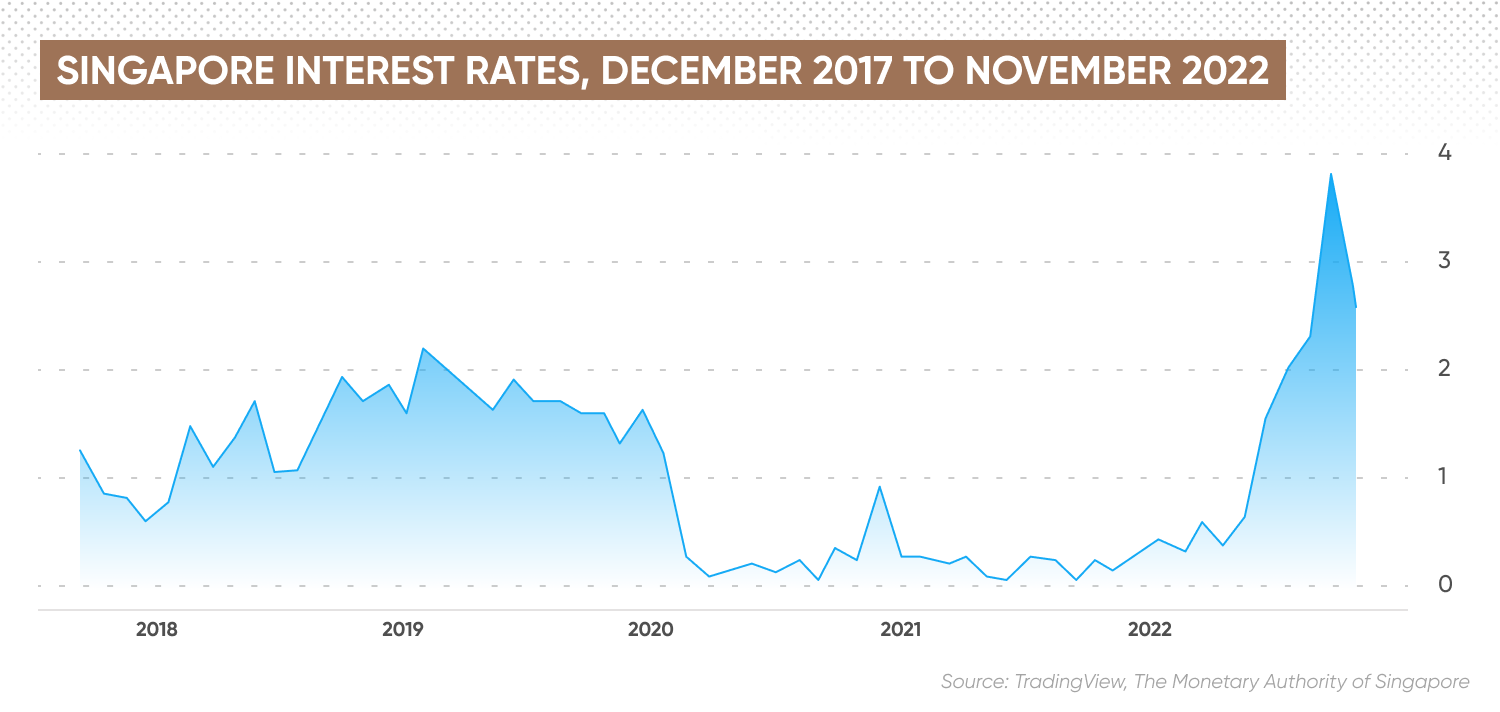Projected Singapore interest rate in 5 years: MAS signals more hikes, predicts eventual prevailing level to remain elevated
The southeast Asian country is one of the few that has weathered headwinds from a slowing economy
Singapore has been among a handful of countries to ha e withstood the headwinds from a slowing global economy due to tightening monetary policy, rising inflation and a strengthening US dollar (USD).
However, as the inflation rate stubbornly remains at a 14-year high, the island nation in Southeast Asia has stepped up its monetary policy. Let’s take a look at the projected Singapore interest rate in 5 years.
About the Singapore central bank
The Monetary Authority of Singapore (MAS) is Singapore’s central bank, established in January 1971.
Unlike most central banks, MAS does not use Singapore interest rates to control inflation. Instead, since 1981, it has managed the Singapore dollar (SGD), aka the Sing, exchange rate against other currencies as its main monetary policy tool.
In Singapore’s small and open economy, the exchange rate has a greater impact on inflation than interest rates. According to the MAS, Singapore spends about 40 cents of every dollar on imports. This is due to the gross exports and imports of goods and services accounting for more than 300% of the country’s gross domestic products (GDP).
The MAS’ monetary policy framework manages the Singapore dollar movement against a trade-weighted basket of currencies of the country’s main trading partners which MAS does not disclose.
US dollar to Singapore dollar live chart
How does MAS monetary policy work?
The trade-weighted SGD exchange rate is also known as the Singapore dollar nominal effective exchange rate (S$NEER). The S$NEER indirectly and directly affects prices in Singapore’s economy, from house rent to wage rates, consumer goods prices and export-import prices.
The MAS allows the SGD to strengthen against peer currencies during times of high inflation, which lowers the price of imported goods. When inflation is low, it allows SGD to depreciate, which raises the price of imported goods.
The central bank sets a defined ‘policy band’, where the SGD appreciates or depreciates against a basket of currencies. The policy band is two parallel lines sloping upwards. When necessary, the MAS will intervene to make sure the SGD does not deviate from the policy band.
The MAS reviews the monetary policy twice a year in April and October and adjusts the following parameters:
-
The slope of the policy band, which is the rate of appreciation
-
The width of the policy band
-
The level at which the policy band is cantered
The MAS can use variations of changing the slope of the band (lifting or lowering the appreciation rate), shifting the centre/mid-point, or widening/narrowing the width of the band to adjust the volatility of the foreign exchange (forex/FX) market.
The central bank does not disclose the parameters for the slope. It describes adjustment to the parameters, such as ‘slight’ increase in the slope or re-centre the mid-point.
‘Re-centring’ the band indicates an aggressive stance by fully lifting or lowering the midpoint to foresee sudden and quick changes in the inflation and growth outlook.
Re-centring downwards involves devaluing the SGD to stimulate growth during times of economic hardship. A weaker SGD makes Singapore’s goods more affordable to foreign buyers, boosting exports.
Singapore interest rate: Historical context
 On 30 March 2020, the MAS set the slope of the policy band at 0%, with the width unchanged, while re-centring or fully moving the band downwards of the prevailing level of the S$NEER amid the Covid-19 pandemic.
On 30 March 2020, the MAS set the slope of the policy band at 0%, with the width unchanged, while re-centring or fully moving the band downwards of the prevailing level of the S$NEER amid the Covid-19 pandemic.
As Covid-19 restrictions slowed economic activity, including travel, the MAS anticipated that Singapore's economy would enter recession that year. Gross domestic product (GDP) projections forecast a decline of 4% to 1%.
The MAS maintained the policy band parameters until October 2021, when it raised the slope slightly but maintained the width and centre in anticipation of rising inflation as Singapore’s and global economy gradually recovered from the Covid-19 restrictions.
On 14 October 2021, Eugenia Victorino, head of Asia Strategy at Swedish financial service company Skandinaviska Enskilda Banken AB (SEB) Group, said that the MAS was estimated to move the SGD appreciation rate to 0.5% a year from 0% in March 2020.
In January 2022, the MAS increased the appreciation rate of SGD again but did not change the width and the center of the band.
In April 2022, MAS opted for double tightening – increasing the appreciation rate and lifting the midpoint of the policy band’s exchange rate. The decision came as MAS anticipated rising domestic prices as energy and commodities prices surge following Russia’s invasion of Ukraine in late February.
The changes in April lifted the S$NEER rate of appreciation to an estimated 1.5% per annum, from 1%. It also moved up the midpoint of the policy band by an estimated 2% from the previous level, Victorino wrote on 14 April.
Since April 2022, Singapore’s central bank has raised the mid-point of the policy band twice – in July and October – while maintaining the rate of appreciation unchanged at 1.5% and the band’s width.
Latest news on interest rate in Singapore
Let’s look at current developments that prompted MAS to take a more aggressive stance.
Inflation rate seen rising
The Inflation rate rose at an annual rate of 7.5% in September. Costs of transportation recorded the fastest rate increase at 19% year-over-year (YoY), according to data from Singapore’s Department of Statistics. Core inflation, which excludes the cost of transportation and accommodation, increased by 5.3%, the steepest rise since November 2008, according to Trading Economics.
The MAS attributed rising inflation to strong demand, which increased imported and domestic costs. Rising global energy and agriculture costs also inflated electricity and gas prices over the previous year.
Economists and analysts who participated in the MAS’ Survey of Professional Forecasters in September 2022, lifted the core inflation forecast for 2022 to 3.8%, from the 3.4% estimate in June. They also raised the Consumer Price Index (CPI) inflation estimate for 2022 to 5.7% from 5% in the previous estimate.
MAS expected inflation to stay around 5% for the rest of 2022 and into 2023.
Tight labor market to push inflation rate
Unemployment in Singapore has continued to fall, reaching 2% in September, from 2.2% in March and 2.6% in September 2021. The declining rate indicates a tight labour market. As the economy has recovered, companies are competing to find talents, promising higher wages.
The return of foreign workers has further squeezed the country’s labour market, which has relied on overseas talents for long. According to SEB Group, non-resident labour flows increased to around 1.306 million in 2022, but remained lower than 1.427 million in 2019.
As a result, by Q2 2022, average earnings were up 6.8% year on year, well above the long-term pre-pandemic average of 3.7%.
SEB forecast headline inflation of 4.3% in 2023, from an estimated 6% in 2022. Respondents in MAS’s survey expected the unemployment rate to stay at 2% in 2022.
Slowdown in trading partners to dim growth
In the September quarter of 2022, Singapore’s GDP grew stronger than expected at 1.5%. This marked a rebound from a 0.2% contraction in Q2, and was attributed to strength in the manufacturing sector.
The MAS projected the economy could grow below trend in 2023 on headwinds from slowing global growth and manufacturing exports amid high inflation and tightening in monetary policy:
Participants in the bank’s survey expected the country’s economy to expand by 2.8% in 2023, slowing from a projected 3.5% in 2022.
Tightening monetary policy to boost SGD
Despite losing about 4% against the US dollar so far this year, the Sing has outperformed other global currencies. Analysts expected that while USD strength would limit the SGD’s appreciation, MAS’ re-centering could strengthen it against most of its trading partners’ currencies
SEB’s Victorino forecast USD/SGD to trade 1.43 by the end of 2022:
Sim Moh Siong, currency strategist at the Bank of Singapore, felt it could be difficult for SGD to beat the USD as the US Federal Reserve (Fed) still keeps its hawkish tone:
Projected Singapore interest rates: 2022 and beyond
As the country’s central bank does not use the common interest rate policy, analysts did not have Singapore’s interest rate forecasts.
Nicholas Mapa, senior economist Philippines at Dutch bank ING Group, expected the MAS to keep its hawkish tone until signs of price increase moderated.
Victorino of SEB Group shared similar view, saying:
Bank of Singapore’s Sim Moh Siong expected intensifying growth risks and higher inflation forecast for 2023 set a bigger hurdle for upside surprises.
“The hurdle for another re-centering is high but it is too soon to call an end to the tightening cycle.”
Analysts did not provide Singapore interest rate forecast for 2025 and Singapore interest rate forecast for 2030.
Final thoughts
Analysts expected the MAS could continue its aggressive monetary policy by re-centring the midpoint until inflation drops to a moderate level. However, they did not give Singapore’s long-term interest rate forecast.
Always conduct your own due diligence before trading, looking at the latest news, technical and fundamental analysis, and analyst commentary. Past performance does not guarantee future returns. And never trade money that you cannot afford to lose.
FAQs
Is the interest rate going up in Singapore?
No one can say for sure. Analysts expected the Monetary Authority of Singapore (MAS) could continue its re-centring of the midpoint of its policy band until the inflation rate moderates. However, the MAS does not use interest rates to manage inflation. Therefore, there is no Singapore’s interest rate prediction.
How high will Singapore interest rates go?
The MAS does not disclose exact parameters of its monetary policy, at the time of writing. It has indicated it could continue its hawkish tone. However, circumstances could always change. Always do your own research before making any investment decision. Never invest or trade more money than you can afford to lose.
Where will interest rates be in 5 years?
It’s impossible to say for sure. The Monetary Authority of Singapore (MAS) and analysts do not provide projected Singapore’s interest rates in 5 years.